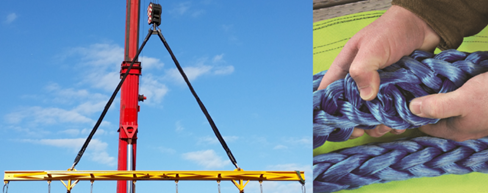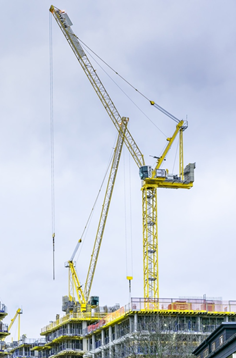The Ultimate Guide to Choosing Rigging Slings

Rigging slings are a significant piece of lifting equipment – even though they are relatively small compared to the large cranes they are used with. Rigging slings support material handling equipment by ensuring that items are not damaged as they are hoisted.
- Wire ropes

- Alloy Chains

- Synthetic Materials

Using the wrong type of rigging sling can be extremely dangerous. This mistake can cause slings to break or loads to fall, causing damage and potential injuries. You must choose the correct type of rigging sling for your application.
If you are in the market to purchase rigging equipment and are wondering which type of sling is best, here are some essential things that you need to know.
What Exactly Are Rigging Slings?
A rigging sling is attached to or wrapped around the object being lifted. It is used in conjunction with a lift or crane.
Since a rigging sling is used for various weights and sizes, it must be routinely inspected for signs of wear. Over time, the material used in the sling will deteriorate and must be replaced.
It is also generally recommended that slings not be shortened or lengthened by knotting and/or twisting. This can wear down the ropes or cables quicker.
Rigging slings are often used with hitches, which then connect to the load.
There are four types of sling hitches:
- Vertical
- Basket
- Choker
- Bridle

A vertical or straight hitch is attached directly to an object (generally by looping around an attached hook) to lift it up vertically. A downside to this type of sling hitch is that the object can rotate or swing while being moved. However, a tagline can be added to help control this rotation and prevent the sling from twisting.

A basket hitch distributes the weight of a load more evenly by splitting it and cradling both slides within a sling. It is typically used in conjunction with a lifting beam or spreader bar to provide additional support.
The angle of the sling does change the load capacity, and both sides need to carry equal weight. Otherwise, the object will topple. Therefore, basket hitches are used on longer objects which are evenly weighted, such as lumber or pipes.

A choker hitch loops around an object to provide a strong grip with an adjustable knot at the top. This also must be used on evenly balanced loads and must be tightly secured before lighting to ensure that the object does not shift.

A bridle hitch is a term used when two or more slings are needed to lift an object. So, two vertical hitches can be used to create a bridle and distribute the weight more evenly between the sling.

The type of material used for a rigging sling is dependent on several factors, such as:
- Application or project
- The load weight, shape, and size
- Center of gravity of the object
- Conditions (wind, clearance, height restrictions)
- Sling and lift angles
So, let’s explain the differences between the three main types of sling materials.
Wire Rope Slings
Wire rope slings are one of the most popular lifting sling choices due to their strength, flexibility, and fatigue resistance. Wire rope products are made up of strands of wires wrapped around one another to create a bendable (yet extremely sturdy) rope.
The material can withstand extreme weights. Wire ropes also have a central core, which is made from steel or fibers, to provide additional support when the rope is bent.

Wire rope has numerous purposes outside of liftings and rigging, such as permanent or temporary attachment securement or material handling.
Wire rope slings have several pattern options:
- Single-layer – typically six strands and one core for lighter lifting applications
- Filler wire – two layers of wire around a core
- Seale – two layers of wire with a smaller inner layer and thicker exterior
- Warrington – two layers of wire. The inner layer has a uniform diameter while the outer layer has different diameters woven in
- Combination – two or more of any patterns woven together to make a single rope
Wire ropes also come in three finishing types: bright, galvanized, or stainless steel.
A “bright” wire rope means that there is no surface treatment on the metal and is instead lubricated to prevent rust and corrosion. This is generally the least expensive type of wire rope.
Galvanized steel has a zinc coating which also protects from corrosion and increases the breaking strength of the wire. This boosts the price point because it offers a higher weight resistance.
Stainless steel wire ropes are the most expensive and are also the most durable. They are highly resistant to corrosion and rust, so they are frequently used on ships or near water.
Although wire rope slings offer numerous benefits, such as strength, flexibility, and resistance to corrosion, there are a few disadvantages.
First, wire rope has a fairly low strength-to-weight ratio and the metal core and exterior can wear down quickly if misused. Wire rope is also non-repairable and must be completely replaced if it breaks.
Common applications for wire ropes include:
- Mining equipment
- Elevator wires
- Crane ropes
- Gas and oilfield equipment
Chain Slings
Chain slings are typically made of an alloy mixture containing varying grades of steel, making them one of the strongest kinds of rigging slings available. Because they are made of chainrings, they are flexible – but do not compromise on strength or durability. The alloy mixture also makes chain slings resistant to extreme temperatures and corrosion.
Chain slings can be used repetitively without wearing down as quickly as wire ropes or other materials. Furthermore, chain links can be repaired or replaced if they break.
Chain slings are usually quite heavy - they have a 4:1 Working Load Limit. So, if an extremely heavy object needs to be lifted, the chain will need to be ¼ of that object’s weight. Alloy chain slings can also be expensive compared to wire ropes or synthetic slings, and they can be easily damaged if they are crushed.
Common applications for chain slings include:
- Heavy-duty lifting
- Foundries, steel mills, heavy machine shops
- Harsh conditions
- Machinery requiring repetitive lifts
Synthetic Slings

Synthetic rigging slings are made of nylon or polyester fibers woven together to create straps that are extremely lightweight and flexible. Since the material is much softer than wire rope or chain slings, they are often used to protect expensive or sensitive loads that could be damaged from scratches. You will commonly see yachts, vehicles, or décor items lifted with synthetic slings.
Synthetic slings come in varying styles depending on the application. Synthetic web slings are flat straps that can be wrapped around an item for lifting. Synthetic round slings are used with vertical, basket, or choker hitches and are best for lifting round objects, like tubes and pipes.
Although synthetic slings are made of fabric fibers instead of metal, they are strong and versatile and have a 5:1 Design Factor. In other words, the breaking strength is five times greater than the Working Load Limit of the sling.
However, one of the disadvantages of this type of sling is that it is easily damaged and can be cut or torn during use. The material is also susceptible to damage from heat, chemicals, and UV rays.
Common applications for synthetic slings include:
- Construction
- Hoists and cranes
- Custom applications
- Light to heavy lifting
Conclusion
Rigging slings are a key component of any lifting application – but you need to have the right material and design. Otherwise, it could compromise the safety and effort of the project.
It is crucial that you understand the differences between the types of rigging slings, as well as the style of hitch to use. Each comes with its own advantages and disadvantages – but there is a combination of every job requirement.
If you have any further questions regarding rigging slings or you are ready to place an order, please reach out to Holloway Houston Inc. Our experienced and knowledgeable team would be glad to help you find the exact lifting equipment needed for any project.
Shop Online Rigging & Lifting Slings









